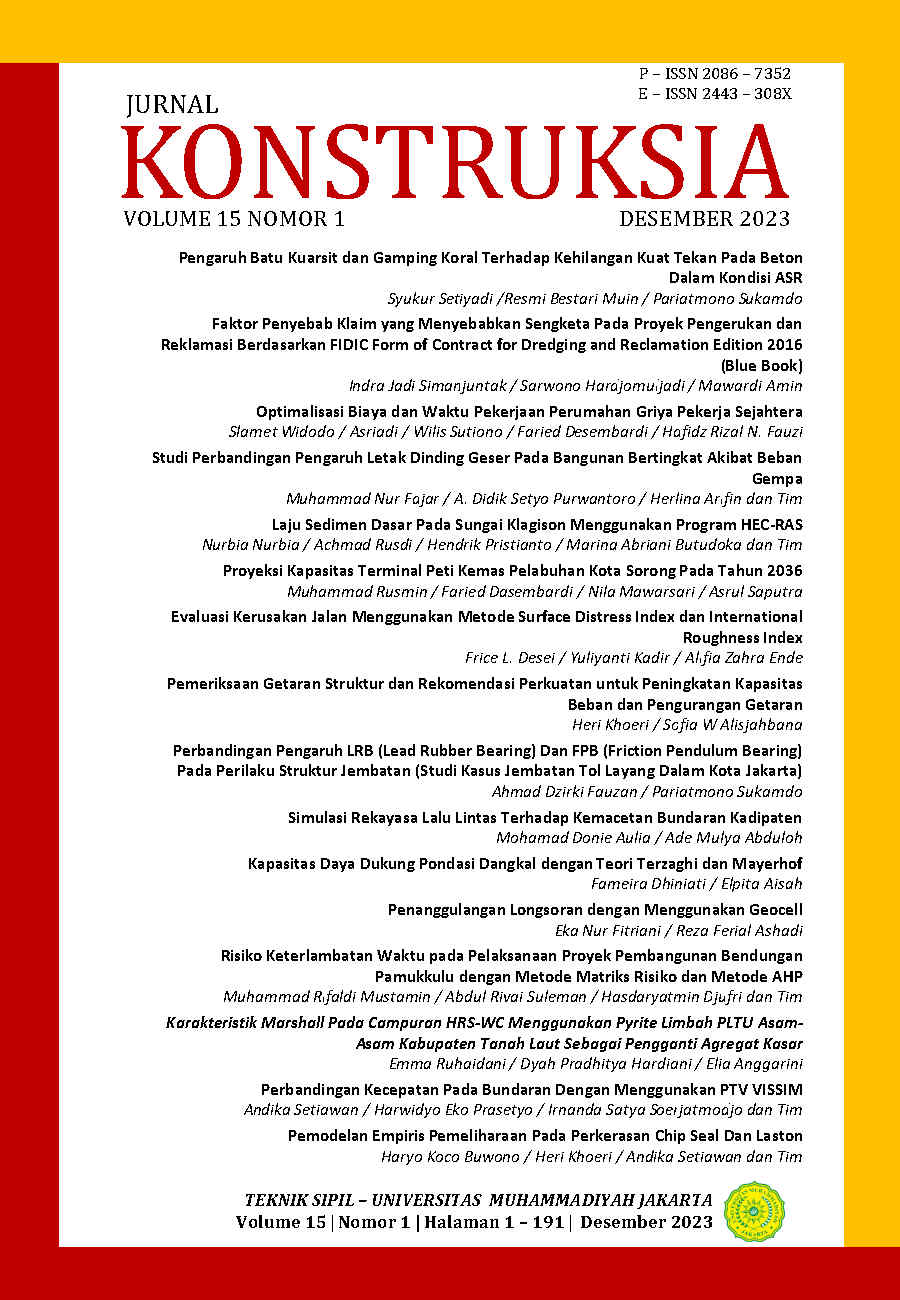Pengaruh Batu Kuarsit dan Gamping Koral Terhadap Kehilangan Kuat Tekan Pada Beton Dalam Kondisi ASR
DOI:
https://doi.org/10.24853/jk.15.1.1-13Keywords:
Agregat Kasar Kuarsit, Agregat Kasar Batu Gamping, Karakteristik Beton, ASR, LICSAbstract
Batu kuarsit dan Batu gamping wilayah pesisir Kab. Pati dan Kab. Blora belum termanfaatkan optimal sebagai agregat kasar [23]. Diteliti sifat fisik agregat kasar serta komposisi kimia, untuk kemudian digunakan dalam mendapatkan karakteristik beton agregat kasar kuarsit dan batu gamping. Pengujian 18 (delapan belas) silinder beton QS 70%:30% LS pada kondisi perawatan terendam air suhu 20°C untuk kuat tekan, kuat tarik belah, dan modulus elastisitas dilaksanakan. Dievaluasi komposisi kimia CaO agregat kasar dan hubungannya dengan kuat tekan beton. Pengujian Lost in Compressive Strength dilakukan atas 6 silinder beton dalam lingkungan ASR 80°C. Penggantian 30% agregat kasar kuarsit (QS) dengan batu gamping (LS) menunjukkan hasil kuat tekan 19.69 MPa dan 29.85 MPa untuk w/c rasio 0.61 dan 0.47 secara berurutan. komposisi kimia CaO (Calcium Oxide) QS dan LS dengan nilai 49.293% dan 54.462%, adapun kandungan SiO2 diperoleh 2.874% dan 1.517% untuk QS dan LS secara berurutan. Terdapat hubungan negatif lemah antara kandungan CaO agregat kasar terhadap kuat tekan beton dan density beton. Terjadi kehilangan kuat tekan (LICS) sebesar -4.7% pada beton w/c 0.61 dan 13.7% untuk beton w/c 0.47, mengindikasikan terdapat peningkatan kuat tekan 4.7% untuk beton w/c rasio 0.61 dan terjadi penurunan kuat tekan 13.7% untuk beton w/c rasio 0.47 pada umur 28 hari lingkungan ASR.References
ACI Committe 211, “Standard Practice for Selecting Proportions for Normal, Heavyweight, and Mass Concrete (ACI 211.1-91),” ACI COMMITTEE REPORT, no. 9, pp. 120–121, 2006.
A. Ahmed et al., “Potential of Waste Marble Sludge for Repressing Alkali-Silica Reaction in Concrete with Reactive Aggregates,” Materials, vol. 15, no. 11, 2022, doi: 10.3390/ma15113962.
A. B. Shuraim, F. Aslam, R. Rizwan Hussain, and A. M. Alhozaimy, “Coupled Effect of Coarse Aggregate Type and Silica Fume on Creep Coefficients of High-Strength Concrete,” Journal of Materials in Civil Engineering, vol. 28, no. 12, p. 04016159, 2016, doi: 10.1061/(asce)mt.1943-5533.0001654.
A. Prado, Y. Coutinho, F. Ferreira, G. Mariano, and A. Carneiro, “Petrographic Evaluation of Aggregates Affected by Tectonic Deformation in Development of Alkali-Silica Reaction,” ACI Mater J, vol. 119, no. 4, pp. 29–33, 2022, doi: 10.14359/51734684.
B4T, “Laporan Pengujian Alkali Reaktif Agregat Gamping,” Balai besar bahan dan barang teknik 2012, no. 14, pp. 4–5, 2022.
B4T, “Laporan Pengujian Alkali Reaktif Agregat Kuarsit,” Balai besar bahan dan barang teknik 2012, no. 14, pp. 4–5, 2022.
B4T, “Laporan Pengujian komposisi kimia Batu Gamping,” Balai besar bahan dan barang teknik 2022, no. c, p. 13506, 2022.
B4T, “Laporan Pengujian komposisi kimia Batu Kuarsit,” Balai besar bahan dan barang teknik 2022, no. c, p. 13506, 2022.
D. Jóźwiak-Niedźwiedzka, K. Gméling, A. Antolik, K. Dziedzic, and M. A. Glinicki, “Assessment of long lived isotopes in alkali-silica resistant concrete designed for nuclear installations,” Materials, vol. 14, no. 16, 2021, doi: 10.3390/ma14164595.
D. Wang, C. Cui, X. F. Chen, S. Zhang, and H. Ma, “Characteristics of autoclaved lightweight aggregates with quartz tailings and its effect on the mechanical properties of concrete,” Constr Build Mater, vol. 262, p. 120110, 2020, doi: 10.1016/j.conbuildmat.2020.120110.
E. Hwang et al., “Compressive creep and shrinkage of high-strength concrete based on limestone coarse aggregate applied to high-rise buildings,” Materials, vol. 14, no. 17, 2021, doi: 10.3390/ma14175026.
E. O. Fanijo, J. T. Kolawole, and A. Almakrab, “Alkali-silica reaction (ASR) in concrete structures: Mechanisms, effects and evaluation test methods adopted in the United States,” Case Studies in Construction Materials, vol. 15, no. November 2020, p. e00563, 2021, doi: 10.1016/j.cscm.2021.e00563.
J. de Brito, R. Kurda, and P. R. da Silva, “Can we truly predict the compressive strength of concrete without knowing the properties of aggregates?,” Applied Sciences (Switzerland), vol. 8, no. 7, pp. 1–22, 2018, doi: 10.3390/app8071095.
J. Malaiskiene, G. Skripkiunas, M. Vaiciene, and E. Karpova, “The influence of aggregates type on W/C ratio on the strength and other properties of concrete,” IOP Conf Ser Mater Sci Eng, vol. 251, no. 1, pp. 1–10, 2017, doi: 10.1088/1757-899X/251/1/012025.
Li. Zongjin, Advanced Concrete Technology. 2011.
Mamlouk, Zaniewski, M. S. and P, J. (2018) Materials for Civil and Construction Engineers Fourth Edition in SI Units Materials for Civil and Construction Engineers FOURTH Edition In si units.
Muhammad. Zuhdi, Buku Ajar Pengantar Geologi. 2019. [Online]. Available: http://eprints.unram.ac.id/14627/1/BUKU AJAR PENGANTAR GEOLOGI.pdf
M. Gunasekaran, N. Vatin, and Y. Vasilev, “Production of Greener High-Strength Concrete Using Russian Quartz Sandstone Mine Waste Aggregates,” pp. 1–13, 2020.
M. S. Islam and N. Ghafoori, “Relation of ASR-induced expansion and compressive strength of concrete,” Materials and Structures/Materiaux et Constructions, vol. 48, no. 12, pp. 4055–4066, 2015, doi: 10.1617/s11527-014-0465-6.
M. S. Islam, “Performance of Nevada’s aggregates in alkali- aggregate reactivity of Portland cement concrete,” pp. 1–386, 2010.
M. S. Mamlouk and J. P. Zaniewski, Materials for Civil and Construction Engineers. 2011.
Pemkab Blora, “Batupasir Kuarsa,” pp. 3–5, 2022.
SNI 7656, “Tata Cara Pemilihan Campuran untuk Beton Normal SNI 7656-2012,” Tata cara pemilihan campuran beton normal, p. 48, 2012.
Y. Huang, Y. Ding, T. Xie, and D. Fei, “Effect of coarse-aggregate shape on strength of hydraulic concrete,” Structural Concrete, vol. 22, no. S1, pp. E710–E719, 2021, doi: 10.1002/suco.201900346.

